PocketBook 626 vs Sony PRS-T3: tested in humans
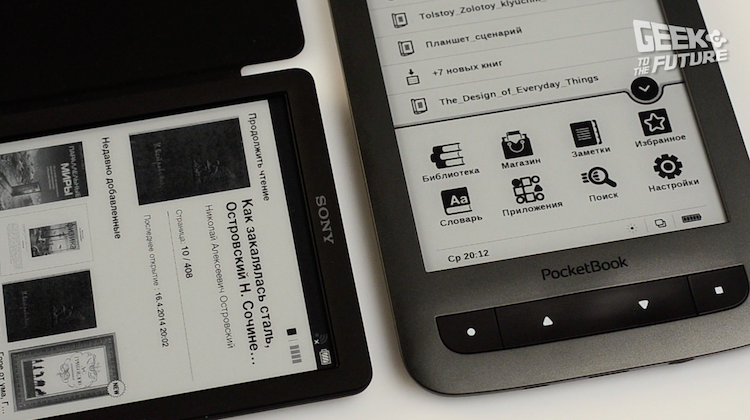
How long have you been holding a book? Plain, paper, smelling time and ink? And e? They say that they, too, managed to go out of fashion. We, paraphrasing Mark Twain, we note that the rumors about the death of readers are greatly exaggerated.
We decided to compare - thanks to the Ulmart online store - two e-books, PocketBook 626 and Sony PRS-T3 . But at the same time we learned from an expert what is happening in this segment of gadgets.
Both readers - and these are the latest models in the device lines of companies - are equipped with E Ink Pearl touch screens with a resolution of 758x1024 pixels. From a technological point of view, this is not the latest development - at the beginning of last year, the next version of the screen on electronic ink E Ink Carta and the first model based on it - Kindle Paperwhite - was presented. However, the new screens have not yet taken root, and readers with E Ink Cart displays still remain a wonder (today, apart from the Kindlow reader, only the freshly eroded German Tolino Vision is equipped with this “generation” of electronic-ink screens).
')

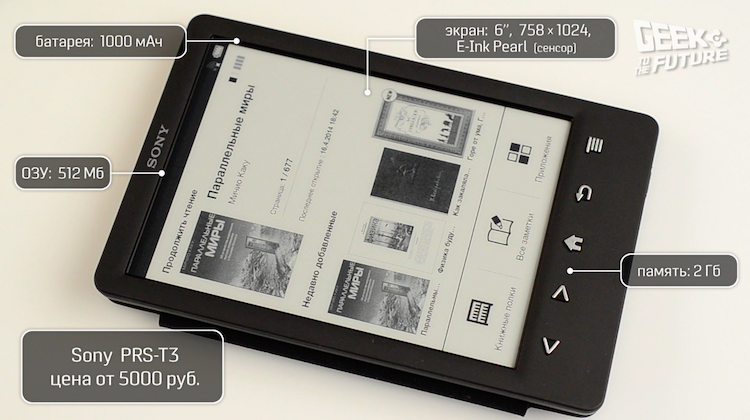
PocketBook 626
from 6000 rub.
Screen: 6 ", 758x1024, 16 shades of gray, E-Ink Pearl, backlight, sensor
RAM: 256 MB
Memory: 4 GB
Wi-Fi, microUSB, microSD (up to 32 GB)
Battery: 1500 mAh
Formats: EPUB, PDF, FB2, FB2.ZIP, TXT, DJVU, HTML, DOC, DOCX, RTF, CHM, TCR, PRC (MOBI) + JPEG, BMP, PNG, TIFF
Sony PRS-T3
from 5000 rub.
Screen: 6 ", 758x1024, 16 shades of gray, E-Ink Pearl, sensor
RAM: 512 MB
Memory: 2 GB
Wi-Fi, USB, microSD (up to 32 GB)
Battery: 1000 mAh
Formats: EPUB, PDF, FB2, TXT + JPEG, BMP, PNG, GIF
Before we compare the devices in detail, we talked with the chief editor of the-ebook.org portal, Vladimir Prokhorenkov, who spoke about what is happening with e-books in general.
GTTF: How interesting are the readers today and how has this gadget market segment changed at all?
Vladimir Prohorenkov: The main peak of interest was literally two years ago. Now the consumer crisis is also being imposed on popularity. Accordingly, the demand decreased slightly. There is an outflow of those companies that are not enthusiastic in the market. Gradually, a limited number of manufacturers remain and until they can surprise with some innovation - all the devices on the shelf resemble each other like two drops of water. The market can spur a new wave of readers, which will offer consumers some property that will distinguish them from the old generation of devices. There is not even stagnation, but some decrease in interest.
GTTF: How will technology develop in general, what is waiting for us in the near future?
VP: At the end of last year, new items came out - this is the new E-Ink Carta screen and the joint development of Sony and E-Ink of 13.3 inches in size, which uses the Sony matrix, which can be bent within certain limits. Accordingly, there will be products in this direction. They are interesting mainly for the corporate market due to the high price.
GTTF: Does the user need such screen flexibility?
VP: Modern screens are glued to glass substrates, so even if the screen remains intact as a result of excessive exposure, the substrate easily breaks. The flexible control TFT layer allows you to bend the screen - the device can be slightly bent or lean on it by hand.
GTTF: What do you advise the person who buys the reader for the first time?
VP: First, decide on what it will read, books in what formats. Then - in what conditions will he do it: is there enough light or will it be a dark room, will he do it in transport or before going to bed.
GTTF: How much can price affect the choice?
VP: It is not necessary to pay the maximum possible amount. High price is, as a rule, marketing positioning. Therefore, it is necessary to focus not so much on price as on those properties that the consumer wants to see in the final product.

What is unique about E Ink technology - even from the side, look, even under the spotlight - the information remains easily distinguishable. The screens of both readers are exactly the same - if you carry out a "blind test", even the developers themselves are unlikely to distinguish one model from another. Font rendering here has improved in comparison with previous models, and this is important for comfortable reading.
PocketBook is equipped with a backlit screen - by the way, more uniform than in previous models - but not completed with a cover. Sony is the opposite - and this is the main difference between the readers from each other. For information: a good PocketBook case will cost about 1000 rubles, and a backlit case for Sony can be found for 1500.


Feels like it is convenient to use, and that, and another reader. Assembly and materials of the case - do not cause questions. PocketBook due to the thickness and curved back cover (without a case) looks a bit more elegant, and Sony boasts comfortable embossed buttons.
The amount of internal memory is not so relevant for readers - unless you read in PDF format. Nevertheless, Sony was equipped with two, and PocketBook - with four gigabytes of memory (of course, smaller volumes are available). Both books support microSD cards (up to 32 GB).

A more important parameter is format support. PRS-T3 works with a minimum set of standards: ePub, PDF, TXT, FB2 + common graphic file formats. The 626th also supports graphics, and the number of text formats here is under two dozen. Of the most valuable - DjVU and Word files.
Mobile applications have long settled in the reader. On the Sony reader, you will certainly be interested in the possibility of working with Facebook and Evernote - in the first case, you can share quotes from books, in the second case, create and read your own notes. PocketBook can work with Dropbox, and besides, there is a useful service for downloading books via Wi-Fi (registration is required, and sending books to the reader is done via email).
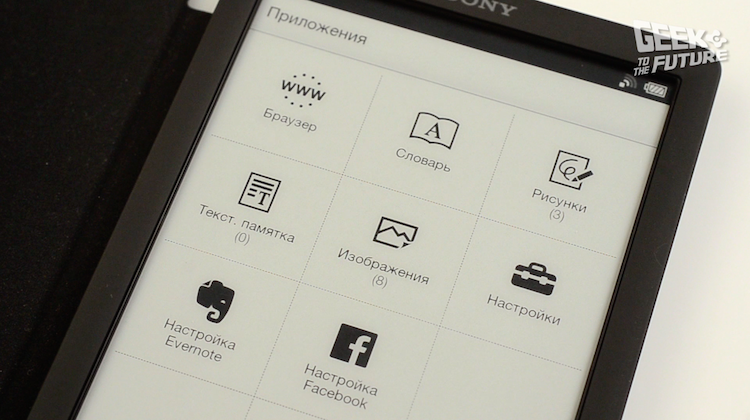
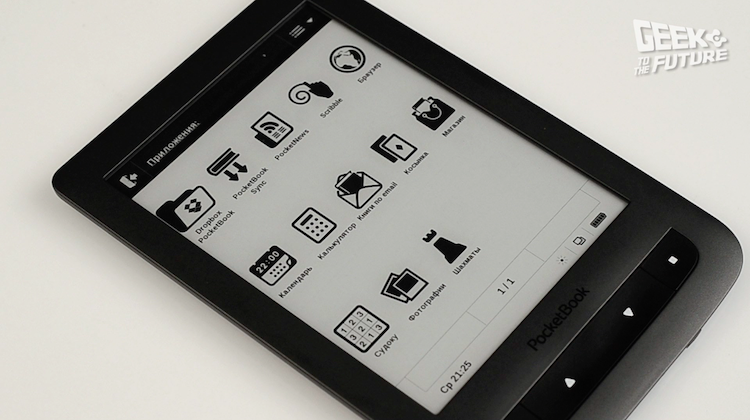
Yes, both models are equipped with Wi-Fi. What else do you need to access the Internet? That's right, the browser! The thing is useful, but it is unlikely that you will use this opportunity often. Why? Permanent redrawing of the screen — food is not for the faint of heart (see how it looks in our video on the Geek to the Future YouTube channel).
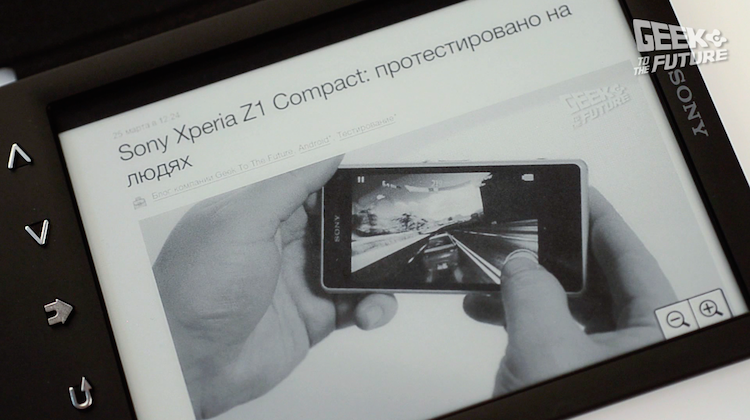
If we talk about speed, then there are no special tests for readers - you can pick up a stopwatch, you can start from subjective sensations. And here Sony is coming forward - all applications and the interface as a whole work without any brakes. Well, everything that relates directly to the reading process is perfected in both gadgets. We also note that the PocketBook sometimes behaved strangely after a reboot: for several minutes the reader braked and reacted poorly to touch gestures, but then he “warmed up” and worked normally.
Here is what is not in any of the readers, so this is an MP3 player. Such a solution has its pros and cons. But in general, given that today the audio player is built into almost irons, the buyer is unlikely to feel deprived. You can, of course, lament the inability to listen to books, but still listen to the monotonous voice of the robot, believe me.
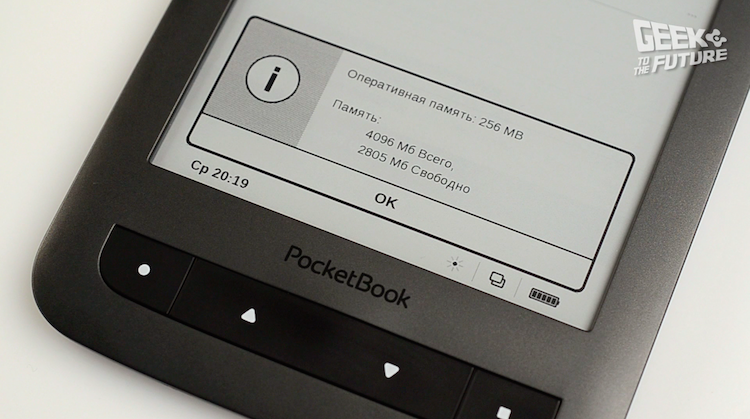
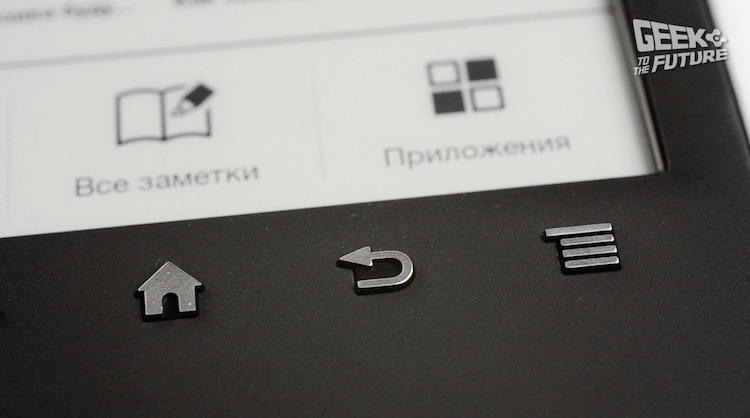
The battery life of readers can be measured in days or the number of pages. But the use of backlighting or “wifi” complicates this task considerably. And the result will, of course, differ from those indicated on the box - moreover, it is known which way. Nevertheless, it is possible to focus on the work of both readers from one charge in a week - a maximum of two - if we talk about “gulp of books”. Well, the backlight will reduce this time by 4-5 times (for Sony, the branded backlit case is powered by the reader’s battery).
To summarize Both devices do not have any pronounced deficiencies and the choice can be made, guided by personal preferences. They are not cheap, but analogs close to them, such as the Onyx Akunin Book, are comparable: in our opinion, both models and other models can be considered as an excellent gadget for everyday reading - see for yourself by watching our comparative video review on the Geek to channel the Future.
Source: https://habr.com/ru/post/221817/
All Articles